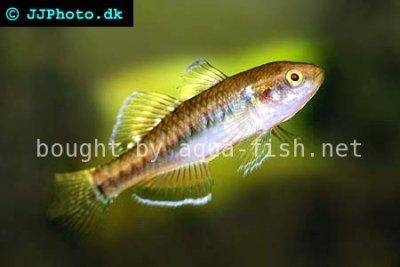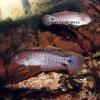Empire gudgeon - Hypseleotris compressa
Scientific name: Hypseleotris compressa
Common name: Empire gudgeon
Family: Eleotridae
Usual size in fish tanks: 11 - 12 cm (4.33 - 4.72 inch)
014
Recommended pH range: 6.5 - 7.4
Recommended water hardness: 3 - 11°N (53.57 - 196.43ppm)
0°C 32°F30°C 86°F
Recommended temperature range: 20 - 27 °C (68 - 80.6°F)
The way how these fish reproduce: Spawning
Where the species comes from: Oceania
Temperament to its own species: peaceful
Temperament toward other fish species: peaceful
Usual place in the tank: Bottom levels
Origin
The Empire Gudgeon (Hypseleotris compressa) is native to Oceania, particularly the estuaries and coastal rivers of Australia. They inhabit a range of environments, from freshwater streams to brackish estuarine waters, often in areas with dense vegetation and submerged debris. These habitats provide ample hiding places and foraging opportunities. Understanding their natural habitat is crucial when setting up a home aquarium, as it allows aquarists to replicate similar conditions, promoting the health and well-being of these fish.
Tank Setup and Environment
Empire Gudgeons are adaptable fish that can thrive in both freshwater and brackish water aquariums. A tank of at least 80 liters (20 gallons) is recommended to accommodate their size and provide them with ample swimming space. To replicate their natural environment, include plenty of hiding spots using rocks, driftwood, and hardy plants like Anubias and Java Fern that can tolerate a range of water conditions. A sandy substrate is ideal.
Maintain a slightly acidic to neutral pH range of 6.5-7.4, and keep the water temperature between 20-27°C (68-80.6°F). While they can adapt to freshwater, they thrive in slightly brackish water conditions, so adding a small amount of marine salt can benefit them. Use a gentle filtration system to keep the water clean without creating strong currents, as they prefer calm waters. Regular water changes are essential to maintain water quality and prevent the build-up of harmful substances.
Food and Feeding
Empire Gudgeons are omnivores and are not fussy eaters, making them relatively easy to feed. They readily accept a variety of foods, including high-quality flake food and pellets. To ensure a balanced diet, supplement their staple diet with regular feedings of live or frozen foods such as bloodworms, daphnia, brine shrimp, and mysis shrimp. These protein-rich foods help enhance their coloration and promote overall health.
Feed them once or twice daily, offering only what they can consume within a few minutes to prevent overfeeding and maintain water quality. Varying their diet not only meets their nutritional needs but also keeps them active and engaged, as they enjoy hunting for live prey. Observing their feeding behavior can also be a good indicator of their health and well-being.
Sexing
Sexing Empire Gudgeons is relatively straightforward. Males display more vibrant colors, particularly during the breeding season, when their fins intensify into striking shades of red. Females, on the other hand, have duller coloration with fins that are more brownish. These differences become more pronounced as they mature, making it easier to identify males and females in a group setting.
Breeding
Breeding Empire Gudgeons in captivity can be a rewarding experience. To encourage spawning, provide a well-maintained tank with plenty of hiding places, such as rocks and dense vegetation. The male's colors will become more vivid as he prepares for spawning. When ready, the female will lay her eggs on a flat surface, such as rocks, plants, or the tank glass. The male takes on the role of protector, guarding the eggs until they hatch, which typically occurs after about 10 days.
Once the fry hatch and become free-swimming, they should be fed with infusoria or other suitable small foods until they grow large enough to accept finely crushed flakes or baby brine shrimp. To maximize the survival rate of the fry, maintain pristine water conditions and ensure that the tank has plenty of cover to keep them safe from potential threats, including the parents.
Lifespan
The Empire Gudgeon has a lifespan of 5-8 years in captivity. With proper care, including a varied diet, stable water conditions, and a suitable tank environment, they can live to their full potential. Their relatively long lifespan for a fish of their size makes them a great addition for aquarists looking for a more long-term companion in their aquarium.
Short Description
Empire Gudgeons (Hypseleotris compressa) are striking, peaceful fish known for their vibrant colors and intriguing behavior. Native to Australia, they are adaptable to a range of water conditions, from freshwater to brackish environments. These fish thrive in aquariums with plenty of hiding places and subdued lighting, mimicking their natural habitats. Despite their peaceful temperament, they are best kept with similarly sized, non-aggressive tank mates. Their vibrant coloration and ease of care make them a favorite among aquarists who are looking for a unique addition to their tank. Whether kept in freshwater or brackish setups, Empire Gudgeons bring a touch of the Australian estuaries to the home aquarium.
Pictures
Bought by aqua-fish.net from jjphoto.dk.



 Peacock
Peacock